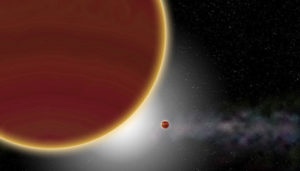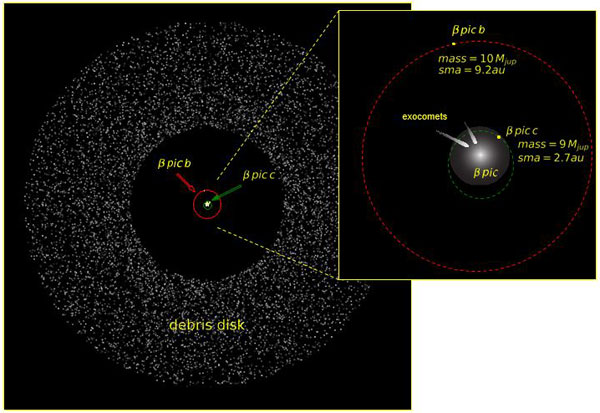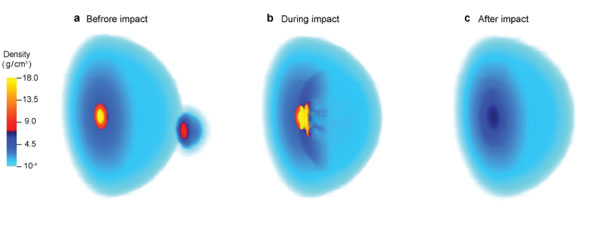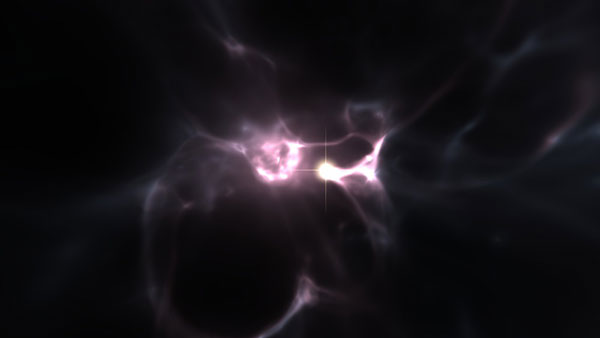60-second Astronomy News: Beta Pic’s New Planet, Jupiter’s Fuzzy Core & An Ancient Star – Sky & Telescope
Astronomers announce another planet around Beta Pictoris, simulations explain Jupiter’s large and fuzzy core, and observations reveal an ancient star.
A New Planet for Beta Pictoris

Artist’s impression of the β Pictoris system. At least two giant planets, about 20 million years old at most, orbit around the star (which is hidden): β Pictoris c, the most recently discovered, and β Pictoris b, which orbits farther out. The disk of dust and gas can be seen in the background.
© P Rubini / AM Lagrange
Astronomers have announced a new giant planet for the Beta Pictoris system, 60 light-years from Earth.
The planet, Beta Pictoris c, is nine times Jupiter’s mass and goes around its star roughly every 3¼ years. Its average distance from its star is 2.7 astronomical units (a.u., the average distance between Earth and the Sun), but its orbit is elongated, so it goes much closer and much farther away.
The planet is part of an already crowded system: The 20 million-year-old star already has one giant planet, seen by direct observation in 2008 about 9 a.u. from the star. It weighs in between 9 and 13 times Jupiter’s mass. And the Transiting Exoplanet Survey Satellite (TESS) also spotted three exocomets zipping around the star.

This diagram shows the disk of dust surrounding β Pictoris, as well as the position of the planets β Pictoris b and c.
© P Rubini / AM Lagrange
The newest discovery was only possible because of 10 years of observation with the High Accuracy Radial Velocity Planet Searcher (HARPS) spectroscope on the European Southern Observatory’s Very Large Telescope in Chile. The scientists had to carefully remove the star’s own pulsations before being able to detect the subtle repeating signal due to the planet’s gravitational tugs as it orbits the star.
The study, led by Anne-Marie Lagrange (University of Grenoble Alpes, France), appears August 19th in Nature Astronomy.
Impact Might Have Mixed Up Jupiter’s Core
Astronomers suggest that in the early, impact-heavy era of our solar system, a protoplanet smashed head on into Jupiter, explaining some of the giant planet’s strange features.
Scientists have long thought that intense pressure might squeeze hydrogen at the planet’s center into an exotic fluid that sloshes within a compact core. Moreover, any elements heavier than hydrogen or helium ought to have sunk into this tiny core. But gravity data collected as NASA’s Juno probe orbits Jupiter have revealed that the gas giant’s core is actually quite large. Heavy elements are mixed up in a region extending to nearly half of Jupiter’s radius. This has presented a challenge to the core accretion theory of planet formation.
Now, astronomers think they might know why Jupiter’s core is so “fuzzy.”
Shang-Fei Liu (Sun Yat-sen University, China) and colleagues published simulations in the August 14th Nature, explaining the possible effects of a giant impact. After simulating multiple scenarios, the team was able to say that a giant impactor — really giant, as it would have had to have 10 times Earth’s mass — could have shattered Jupiter’s primordial compact core shortly after it formed, mixing up the planet’s inner layers.

Snapshots of density distribution during a merger event between a proto-Jupiter and an impactor with 10 times Earth’s mass.
Shang-Fei Liu
The researchers then used the output from the impact simulation for a second set of simulations, which calculated how the planet would have evolved over the next 4.5 billion years. In some of those models, the fuzzy core persisted to the present day.
Read more about the research in the NCCR press release and Rice University’s press release.
Astronomers Discover Ancient Star
Astronomers have discovered an ancient red giant star on the other side of the galaxy, 35,000 light-years from Earth. Designated SMSS J160540.18–144323.1, the star has the lowest iron content of any star yet measured — just one part per 50 billion.
The universe began with the elements hydrogen, helium, and trace amounts of lithium; heavier elements like iron formed later inside stars. So the earlier a star formed, the fewer heavy elements were available. The anemic star, whose iron levels are 1.5 million times lower than the Sun’s, must have formed only a few hundred million years after the Big Bang.
Thomas Nordlander (Australian National University) and colleagues report the discovery in the July 17th Monthly Notices of the Royal Astronomical Society: Letters (full text available here). They first found the star using the 1.3-meter SkyMapper telescope at the Siding Springs Observatory, and later followed up with spectroscopic observations.

This visualization shows the formation of the first stars, known as Population III stars, in a protogalaxy.
Abel Wise / Kaehler (KIPAC / SLAC)
Despite its pristine chemistry, this star still wasn’t one of the first stars. The team’s calculations show that it probably formed after one of the first stars exploded, making it a true second-generation star. The simulations show that the first star was rather unimpressive before it exploded: only about 10 times the mass of the Sun, while most of its compatriots are thought to have been much more massive. Its explosion likewise must have been pretty feeble to explain the low amounts of iron that made it onto the second-generation star.
“We can study the first stars through their children — the stars that came after them, like the one we’ve discovered,” explains coauthor Martin Asplund (Australia National University).
Read more in Scipub and Astro3D’s press release.





